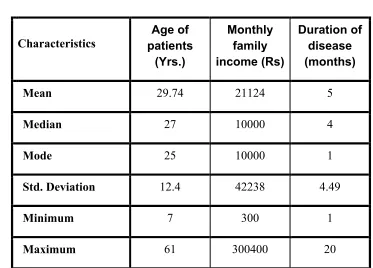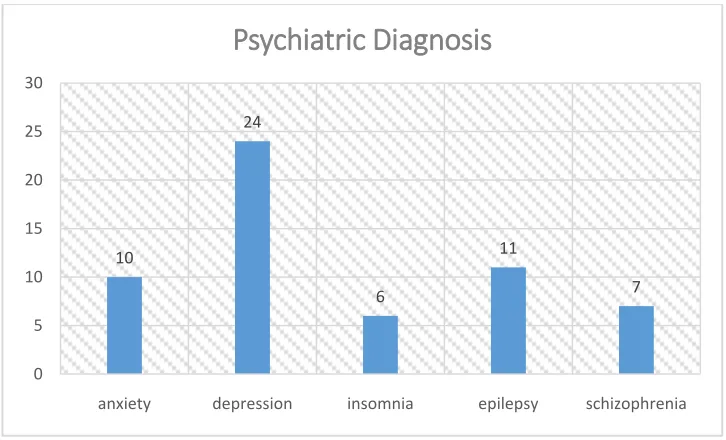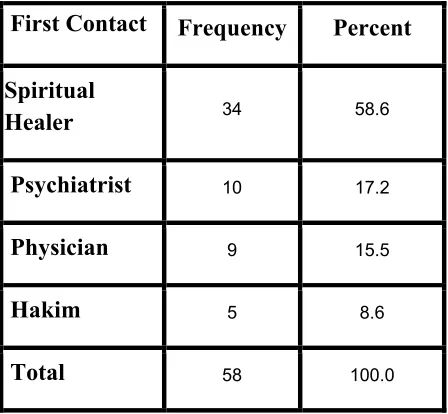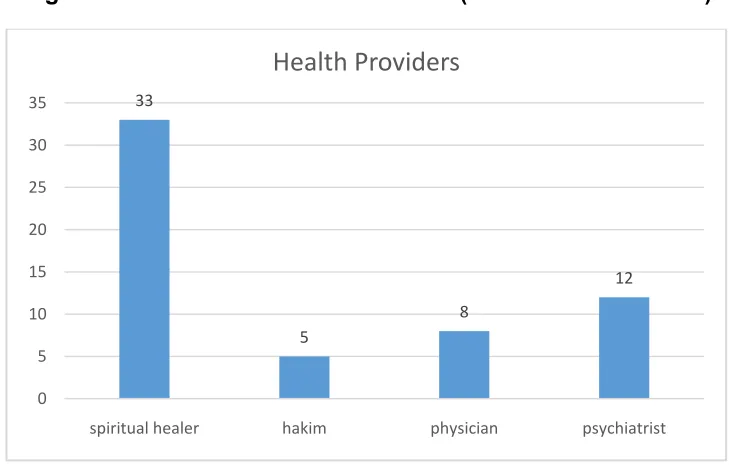Health Seeking Behavior among Psychiatric Patients Attending
Psychiatry OPD of a Tertiary Care Hospital.
Dr.Sajid Akhtar; Dr.Iftikhar Ahmed; Dr.Muhammad Tanveer Aziz.
Abstract
Background: Psychiatric illness is a mental disorder or mental illness which is defined as mental or behavior pattern that causes either suffering or poor ability to function in ordinary life. Such features may be persistent, relapsing & remitting or occur as single episode. Typically social norms & religious or cultural beliefs are excluded. Causes of psychiatric illness are unclear. Mental or psychiatric disorders are usually defined by combination of how a person feels acts, thinks or perceives. Objectives:
To assess the knowledge of health seeking behavior among psychiatric patients.
Methodology: Study Design:Cross-sectional study. Setting:Sheikh Zayed Medical College/Hospital RYK (Psychiatric Ward and OPD)Duration:A period of Three months from 15th February to 15thMay 2017. A predesigned and pre-tested questionnaire was used for data collection.Subjects of study were all the patients who were suffering from Psychiatric illness between 18-65 years of age and of either sex.A total of 58 consecutive patients were included in the
study.Data was entered & analyzed by using SPSS 16. Results: There were total 58 subjects included in study. 64% patients were males and 36% were females. Among them, 41.4% of the patients have depression, 19% have epilepsy, 17.2% have anxiety, 12.1 % have schizophrenia and 10.3 % have insomnia. Out of those, 56.9% of the patients went to spiritual healer, 20.7% went to psychiatrist, 13.8% went to physician and 8.8% went to hakim.
Conclusion: This study showed that more than half of the patients with psychiatric illnesses went to spiritual healers as first contact for health care.
Introduction
DefinitionPsychiatric illness is a mental disorder or mental illness which is defined as mental or behavior pattern that causes either suffering or poor ability to function in ordinary life. Such features may be persistent, relapsing & remitting or occur as single episode.
1. Schizophrenia 2. Anxiety Disorders 3. Panic Disorders
4. Obsessive Compulsive Disorder 5. Alzheimer disease
6. Major Depression 7. Bipolar Disorders 8. Agoraphobia
9. Post-Traumatic Stress Disorder 10.Epilepsy
Health Seeking Behavior among Psychiatric Patients in Pakistan
Most of population in Pakistan goes to Spiritual Healers & Quacks for their treatment, only few go to psychologists, psychiatrists or medical practitioners.
They receive treatment like ‘Phakki’, ‘Dam Darood’ and in some cases beaten by stick and tortured by hot objects which worsens the condition of the patient.
Factors Affecting the Health Seeking Behavior
The following factors affect the health seeking behavior:
1. Stigma
Many people do not fully participate in the treatment
due to stigma to avoid the label of mental illness and the harm it brings.
2. Illiteracy
Due to poor literacy rate in Pakistan, people avoid to go to psychiatrists.
3. Distance
Some villages are far away from Hospitals, so people are reluctant to go to Hospitals and find it convenient to go to Spiritual Healers and Quacks.
4. Economic Status
Due to poor economic status some people cannot afford to go to psychiatrists.
5. Norms & Beliefs.
Majority of people in villages have specific norms & beliefs regarding psychiatric disorders.
Outcome of Wrong or Delayed Treatment
5.
Non-adherence to TreatmentOBJECTIVES
The objectives of this study were to:
• determine the psychiatric patient’s choice of health care provider for treatment.
• determine the expenditure of psychiatric patients according to health care provider.
• assess the distance travelled by psychiatric patients on each visit.
• know the demographic profile of psychiatric patients.
• know the pattern of psychiatric illness among psychiatric patients.
Methodology
Study Design:
Cross sectional study.
Study Setting:
OPD & ward of Psychology Department of Sheikh Zayed Medical College/Hospital, Rahim Yar Khan.
Study Subjects:
All the patients who were suffering from Psychiatric illness between 18-65 years of age of both sexes.
Sample Size:
A total of 58 consecutive patients were included in the study.
Sampling Techniques:
Convenient sampling technique was used & data was collected from all patients in duration of one month.
Duration:
Data was collected in all consecutive patients of psychiatry coming to OPD & ward of psychiatry in duration of Three months from 15th February to 15th May 2017.
Inclusion Criteria:
Patients of both sexes & age between 18-65 years, using health seeking behavior.
Exclusion Criteria:
Children less than 18 years of age. Old age patients of 65 years &
above.
Data was collected from OPD & ward of Psychiatry Department, SZH, R.Y. Khan, using a predesigned and pretested questionnaire.
Data Analysis:
Data was entered & analyzed by using SPSS 16. The frequencies and percentages were calculated on categorical variables. Means and Standard Deviation were calculated on numerical variables.
RESULTS
Table 1: Characteristics of Patients
Table 1 shows that median age of the patient was 27, median family income of the patient was 10000(Rs) and median duration of the disease of the patient was4.
Table 2: Pattern of Psychiatric Illness among Patients
Characteristics
Age of patients
(Yrs.)
Monthly family income (Rs)
Duration of disease (months)
Mean 29.74 21124 5
Median 27 10000 4
Mode 25 10000 1
Std. Deviation 12.4 42238 4.49
Minimum 7 300 1
Illness Frequency Percent
Depression 24 41.4
Epilepsy 11 19.0
Anxiety 10 17.2
Schizophrenia 7 12.1
Insomnia 6 10.3
Total 58 100.0
Table 2 shows that 41.4% of the patients have depression, 19% have epilepsy, 17.2% have anxiety, 12.1 % have schizophrenia and 10.3 % have insomnia.
Figure I: Pattern of Psychiatric Illness
10
24
6
11
7
0 5 10 15 20 25 30
anxiety depression insomnia epilepsy schizophrenia
Figure I shows that most frequent illness was depression, epilepsy & anxiety.
Table 3: Patient’s First Contact with Health Care Provider
First Contact Frequency Percent
Spiritual
Healer 34 58.6
Psychiatrist 10 17.2
Physician 9 15.5
Hakim 5 8.6
Total 58 100.0
Table 3 shows that 58.6% of the patient went to spiritual healer at their first contact, 17.2% went to psychiatrist at their first contact, 15.5% went to physician at their first contact and 8.6% went to hakim at their first contact.
Table 4: Patient’s Second Contact with Health Care Provider
Second Contact Frequency Percent
Psychiatrist 32 55.2
Physician 12 20.7
No Contact 9 15.5
Hakim 3 5.2
Spiritual healer 2 3.4
Table 4 shows that 55.2% of the patient went to psychiatrist at their second contact,20.7% of the patient went to physician at their second contact,15.5% went nowhere at their second contact,5.2% went to hakim at their second contact and 3.4% went to spiritual healer at their second contact.
Table 5: Patient’s Third Contact with Health Care Provider
Third Contact Frequency Percent
No Contact 36 62.1
Psychiatrist 19 32.8
Spiritual healers 2 3.4
Hakim 1 1.7
Total 58 100.0
Table 5 shows that 62% of the patient went nowhere at their third contact, 32.8% went to psychiatrist at their third contact, 3.4% of the patient went to spiritual healer at their third contact and 1.7% of the patient went to hakim at their third contact.
Table 6: Patient’s Fourth Contact with Health Care Provider
Fourth
Contact Frequency Percent
No Contact 55 94.8
Psychiatrist 3 5.2
Table 6 shows that 94.8%of the patient went nowhere at their at their fourth contact and
5.2% of patient went to psychiatrist at their fourth contact.
Table 7: Contact wise Expenditure (Rs) Incurred during each Visit
Table 7 shows that the median expenditure was low in first in contact (Rs. 500) and high in fourth contact, median Rs. 3000.
Figure II: Overall Source of Treatment (Health Care Provider)
33
5
8
12
0 5 10 15 20 25 30 35
spiritual healer hakim physician psychiatrist
Health Providers
Characteristics Expenditure on first contact
Expenditure on second
contact
Expenditure on third
contact
Expenditure on fourth
contact
Mean 1811 1885 1092 3000
Median 500 1000 500 3000
Mode 0 500 0 0
Std. Deviation 3978.5 2561.4 1784.8 4242.6
Minimum 0 0 0 0
Figure II shows that most frequent source of treatment was Spiritual Healers followed by Psychiatrists.
DISCUSSION
This cross sectional study was conducted to assess the health seeking behaviour among psychiatric patients admitted in a tertiary care hospital. In this study, median age of the patient was 27, median family income of the patient was 10000(Rs) and median duration of the disease of the patient was 4 months. Our study showed that 64% patients were males.
Our study showed that 36.2% of the patient have education up to Primary level and 33% were illiterate, Our study showed that 81% of patient's mothers were illiterate and 46.6% of patient's fathers were illiterate. Median expenditure was low in first in contact (Rs=500) and high in fourth contact, median Rs=3000. Our study showed that 20.7% of the patient were students, 19% were farmers and housewife and public servants were 17.2%. Our study showed that 63.8% of the patients were married and 34.5% of the patients were unmarried. Our study showed that 67.2% of the patients
belonged to urban area and 33.8% belonged to rural area.
Our study showed that 41.4% of the patient have depression, 19% have epilepsy, 17.2% have anxiety, 12.1 % have schizophrenia and 10.3 % have insomnia.
Our study showed that 56.9% of the patients went to spiritual healer, 20.7% went to psychiatrist, 13.8% went to physician and
8.8% went to hakim.
Our study showed that 58.6% of the patient went to spiritual healer at their first contact, 17.2% went to psychiatrist at their first contact, 15.5% went to physician at their first contact and 8.6% went to hakim at their first contact.
at their third contact, 32.8% went to psychiatrist at their third contact, 3.4% of the patient went to spiritual healer at their third contact and 1.7% of the patient went to hakim at their third contact. Regarding fourth contact, 94.8%of the patient went nowhere at their at their fourth contact and 5.2% of patient went to psychiatrist at their fourth contact.
CONCLUSION
Our study showed that most frequent source of health care provider for psychiatric patients was spiritual healers as compared to one-third who went to qualified healthcare providers like psychiatrists or physicians. More psychiatric patients got health care from qualified persons as the number of contact increased. The cost of health care was high with qualified persons as compared to spiritual healers.Health education aiming at increasing awareness among general population regarding treatment options is recommended.
SUGGESTIONS
• Emphasis should be laid on the awareness of psychiatric patients
about the management and
prevention of the psychiatric disorders.
• Media coverage should be used to discourage the concept of psychiatric disorders to be taken as social stigma.
• Seminars should be conducted for the awareness of general public about the psychiatric disorders.
• Conventional methods of treating psychiatric disorders i.e Hakeem, Spiritual healers etc should be discouraged.
•
REFERENCES
1.American Psychiatric Association. DSM-III: Diagnostic and Statistical Manual of Mental Disorders.3rd ed. APA, Washington, DC; 1980. 2. Berrios G E (April 1999). "Classifications in psychiatry: a conceptual history". Aust N ZJ Psychiatry. 33 (2): 145–60. doi:10.1046/j.1440-1614.1999.00555.x. PMID 10336212.
International Consortium in Psychiatric Epidemiology. Bull. World Health
Organ. 78 (4): 413–26.
2000.
doi:10.1590/S0042-96862000000400003. PMC 2560724 .PMID 10885160.
4. Buckley PF; Miller BJ; Lehrer DS; Castle DJ
.Psychiatric comorbidities
&schizophrenia. Schizophr(2009)35 (2): 383– 402. doi:10.1093/schbul/sbn135.PMC 2659306
. PMID 19011234.
5. Ernst E. "Spiritual healing: more than meets the eye". J Pain Symptom Manage(209). 32 (5): 393–
5. doi:10.1016/j.jpainsymman.2006.07.010.PMI D 17085260.
6.Smith, R. A. (2009). Stigma communication. In S. Littlejohn & K. Foss (Eds.), Encyclopedia of communication theory (pp 931–34). Thousand Oaks, CA: Sage.
7. National Institute of Mental Health. (2006, January 31). Information about Mental Illness and the Brain. Retrieved April 19, 2007, from
http://science-education.nih.gov/supplements/nih5/Mental/gui de/info-mental-c.htm.
8 Jackson, J. "Structural characteristics of norms". In I.D. Steiner & M. Fishbein
(Eds.), Current studies in social psychology(1965) (pp. 301-309).
9. Nitin Mishra, Sajanjiv Singh Nagpal, Rakesh K. Chadda, and Mamta Sood. Help-seeking behavior of patients with mental health problems visiting a tertiary care center in north India. Indian J Psychiatry. 2011 Jul-Sep; 53(3): 234– 238.
10. Samuel B. Harvey, Matthew Hotopf, Simon Øverland, Arnstein Mykletun, The British Journal of Psychiatry Oct 2010, 197 (5) 357-364).
11.Emily Klineberg, Lucy Biddale, Jenny Donovan, David Gunnell. Symptoms recognition and health seeking for depression in young adults. Social Psychiarty and Psychiatric Epidemiology 2011;46(6); 495-505).
12. Nitin Mishra, Sajanjiv Singh Nagpal, Rakesh K. Chadda, and Mamta Sood. Help-seeking behavior of patients with mental health problems visiting a tertiary care center in north India. Indian J Psychiatry. 2011 Jul-Sep; 53(3): 234– 238.




